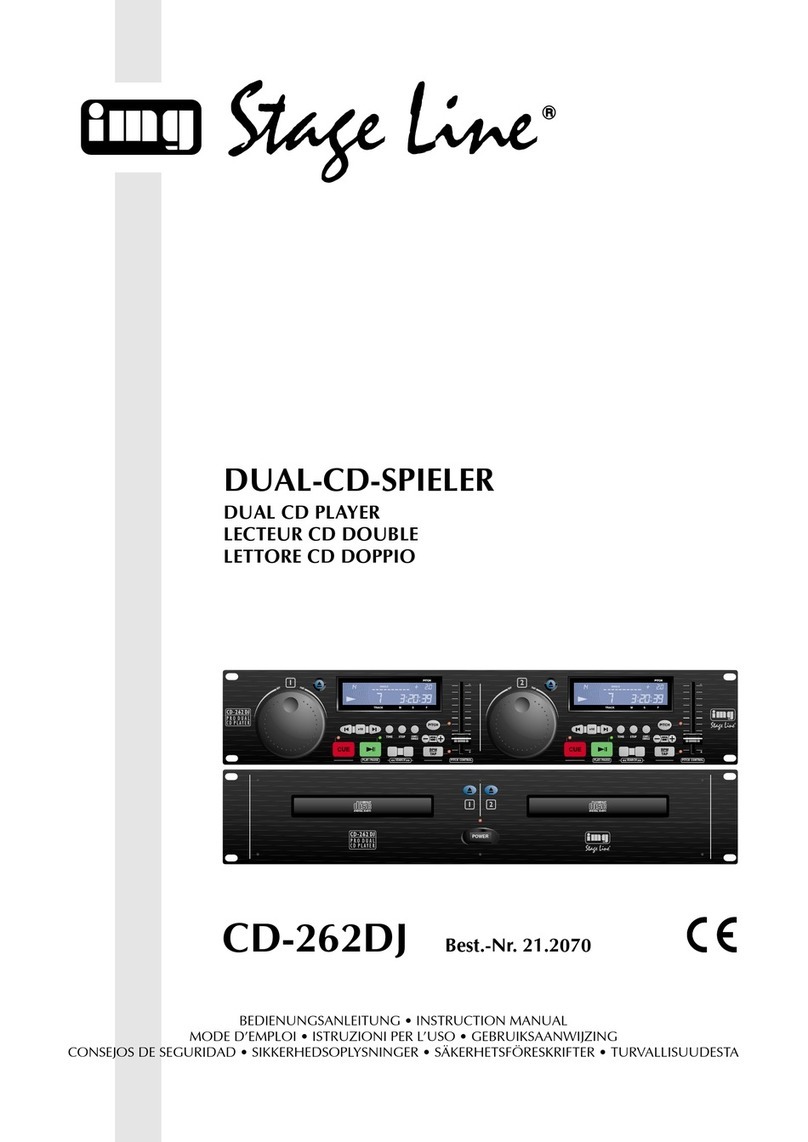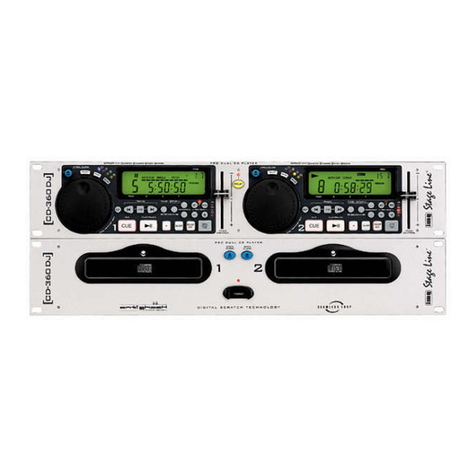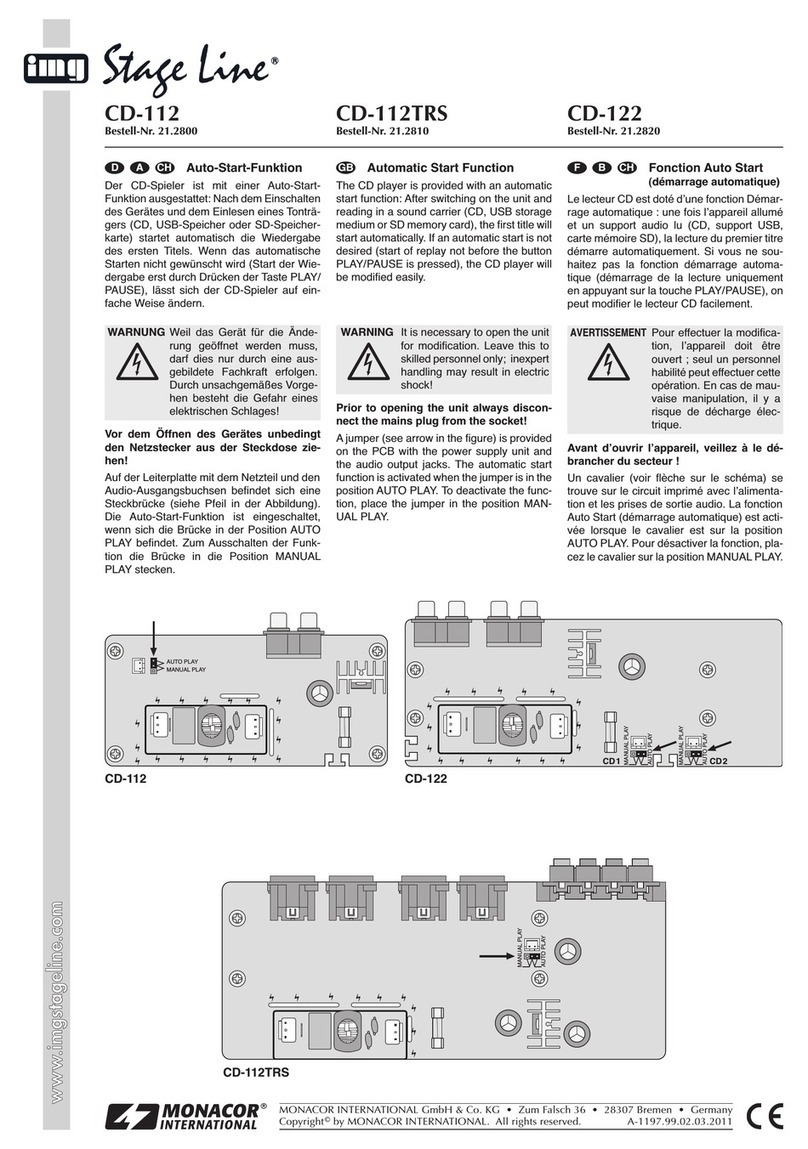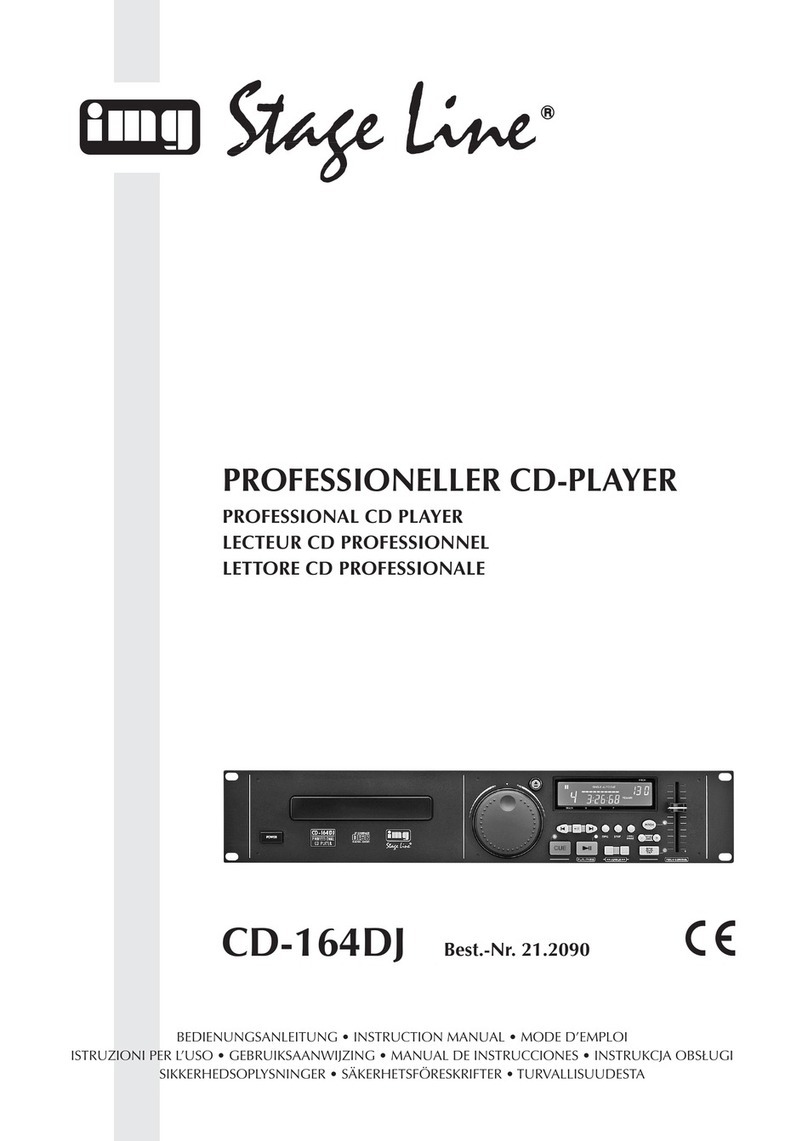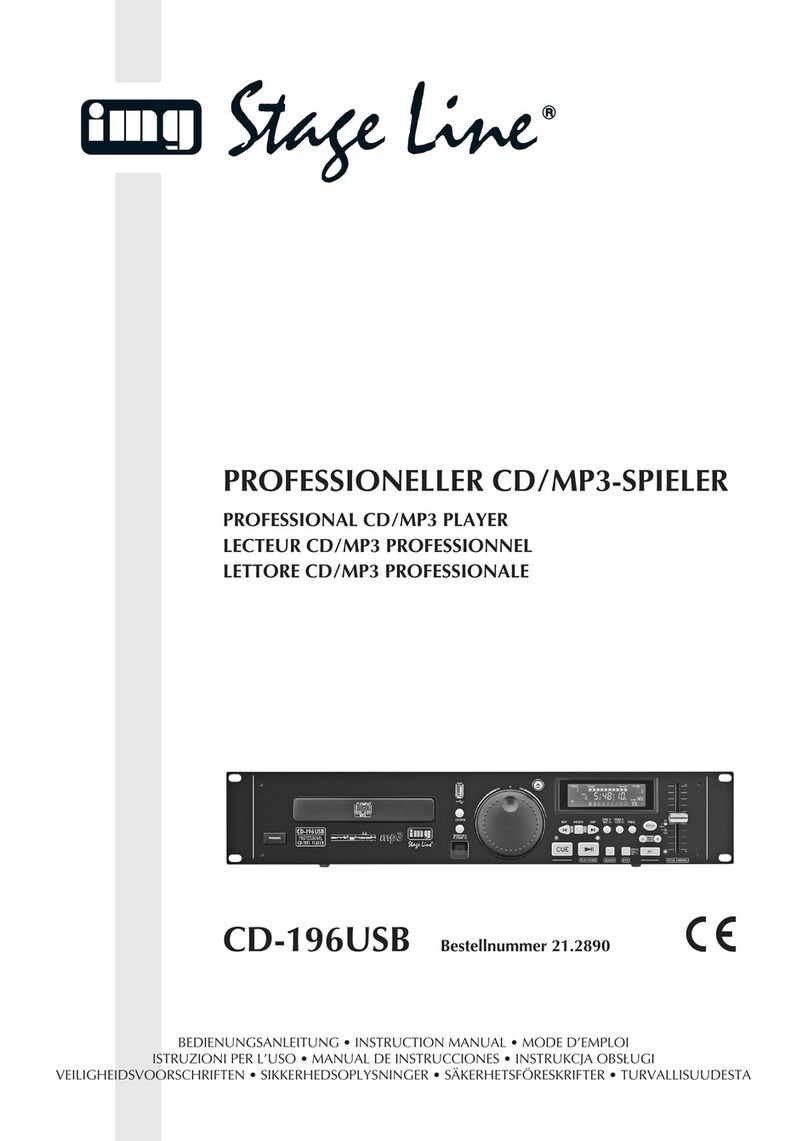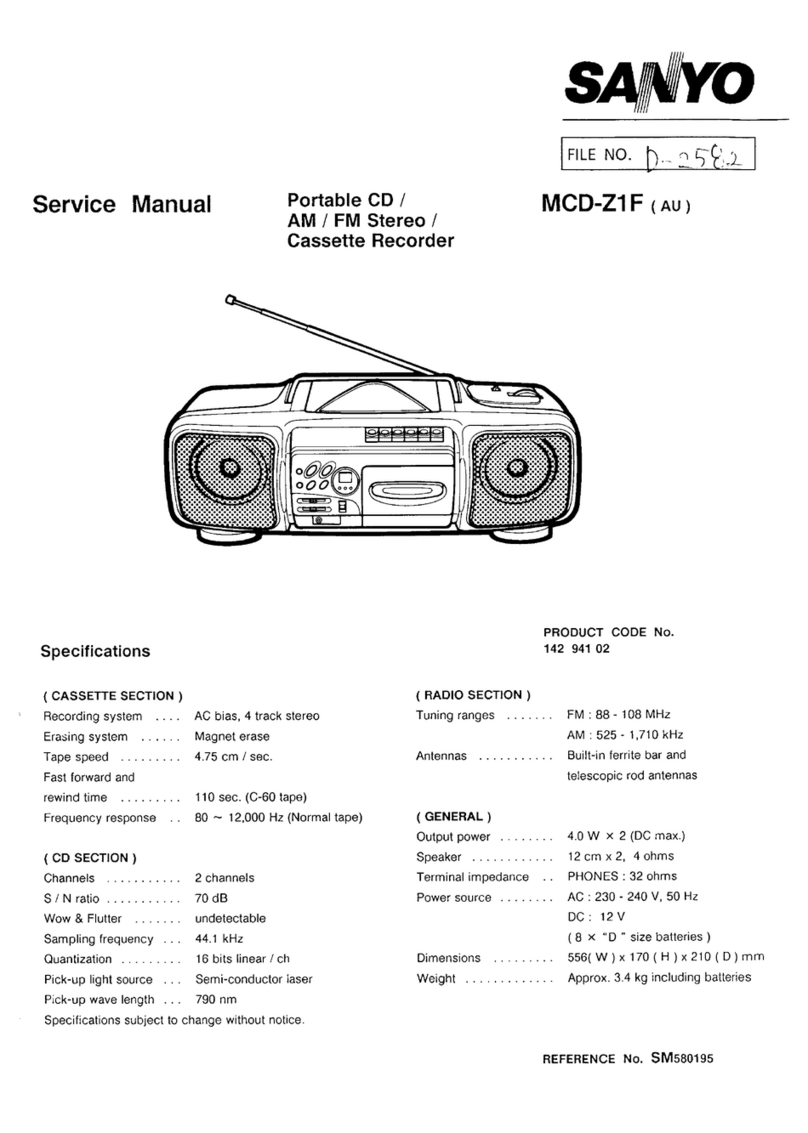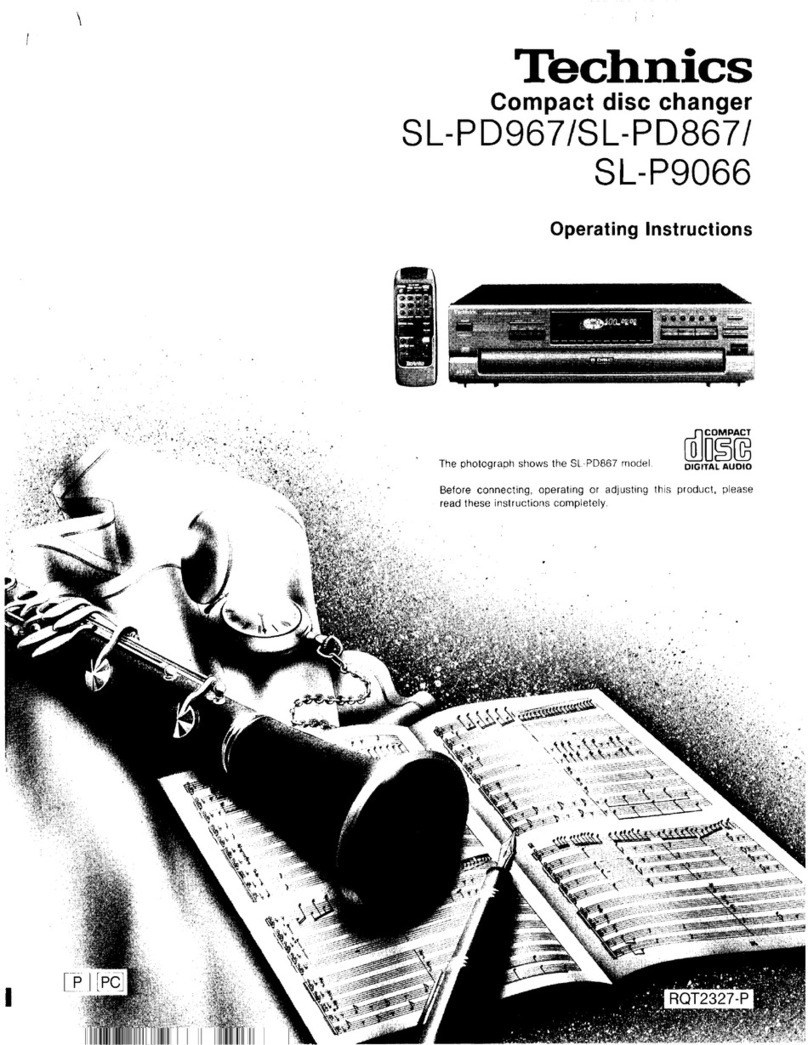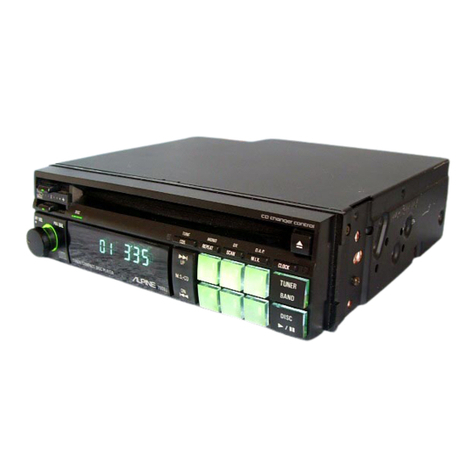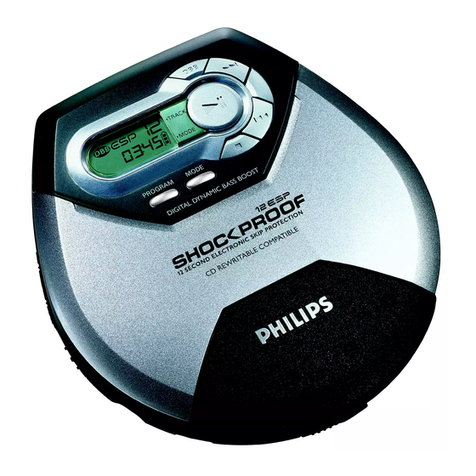lAnzeige der mit dem Regler PITCH CON-
TROL (29) eingestellten Geschwindigkeits-
änderung (max. ±100%)
mAnzeige „KEY“: blinkt, wenn die Transponier-
funktion nicht aktiviert ist. Dach dem Drücken
der Taste KEY (12) ist diese Funktion einge-
schaltet und die Anzeige „KEY“ leuchtet kons-
tant (siehe Kap. 5.11)
nSymbol für den Wiedergabemodus
oSymbol für den Pausenmodus
pWert eines angewählten Effektparameters
(siehe Kap. 6)
qPfeil „CARD“: erscheint, wenn mit der Taste
CARD (16) eine SD-Karte angewählt wurde
rPfeil „EFFECT“: erscheint, wenn mit den Zif-
ferntasten (10) die Klangeffekte angewählt
werden können. Das Umschalten zwischen
Titel- und Effektauswahl erfolgt mit der Taste
EFFECT/TRACK (11).
sTextzeile zur Anzeige eines angewählten Ef-
fektparameters oder des Dateinamens eines
angewählten Titels im MP3-Format
tZeitanzeige; siehe Pos. 8 Taste TIME/STOP
uPfeil „+10“: erscheint, wenn mit dem Regler
SET (7) ein Effektparameterwert in 10er-Schrit-
ten veränderbar ist. Das Umschalten zwischen
1er- und 10er-Schritten erfolgt mit der Taste
TRACK +10 (25).
vBargraf: stellt durch seine Länge die Zeitan-
gabe (t) grafisch dar
wAnzeige des eingestellten Wertes für die
Transponierfunktion (Kap. 5.11)
xAnzeige der Taktschläge pro Minute des lau-
fenden Titels (Kap. 5.2.2)
ySymbol : wird angezeigt, wenn der Beatcoun-
ter aufAutomatik geschaltet ist (Kap. 5.2.2)
4Taste RELAY zum automatischen Starten des
anderen Laufwerks am Ende eines Titels oder
am Ende des letzten Titels (Kap. 5.3.3)
Die Funktion lässt sich nur aktivieren, wenn in
jedem Laufwerk eine CD eingelegt ist oder eine
SD-Karte eingesteckt und angewählt ist.
5Drehknopf SELECT zur Anwahl eines Effektes,
dessen Parameter verändert werden soll;
zum Bestätigen der Auswahl den Knopf kurz
drücken, es wird dann ein Parameter angezeigt;
zur Auswahl eines anderen Parameters den
Knopf erneut drehen (Kap. 6)
6Taste EJECT zum Auswerfen der CD
(nicht während der Wiedergabe oder bei ange-
wählter SD-Karte möglich)
7Drehknopf SET zum Einstellen der Effektpara-
meter [nach der Auswahl mit dem Drehknopf
SELECT (5)] oder, wenn kein Parameter in der
Textzeile (s) angezeigt wird, zum Einstellen des
Wertes für die Transponierfunktion; durch Drü-
cken des Knopfes wird der Einstellmodus für die
Effektparameter wieder verlassen
8Taste TIME/STOP:
wird die Taste länger als 3 Sekunden gedrückt
gehalten, stoppt das Laufwerk;
zur Umschaltung der Zeitanzeige (t und v) die
Taste nur kurz antippen:
Grundeinstellung, Anzeige „REMAIN“ (h):
Restzeit des laufenden Titels
erster Tastendruck, Anzeige „ELAPSED“ (e):
bereits gespielte Zeit des laufenden Titels
nächster Tastendruck, „TOTAL REMAIN“ (g+h):
Restzeit der gesamten CD;
nicht bei Titeln im MP3-Format möglich
nächster Tastendruck, Anzeige „REMAIN“:
Zurückschalten auf die Grundeinstellung
9Taste CONT. SINGLE/OUTRO zur Auswahl des
Betriebsmodus (siehe auch Kapitel 5.3) und zum
Einschalten der Funktion OUTRO
Grundeinstellung, Anzeige „SINGLE“ (d):
Einzeltitelwiedergabe; nach jedem gespielten
Titel schaltet das Gerät auf Pause
erster Tastendruck, Anzeige „CONT” (f):
fortlaufende Wiedergabe aller Titel der CD
bzw. der SD-Karte
zweiter Tastendruck, Anzeige „SINGLE“:
Zurückschalten auf die Grundeinstellung
Die Taste ca. 3 Sekunden gedrückt halten, bis im
Display „OUTRO“ (i) erscheint:
Einschalten der Funktion OUTRO zumAbspielen
der jeweils letzten 30 Sekunden der folgenden
Titel [Durch kurzes Drücken der Taste TIME/
STOP (8) lässt sich die Funktion wieder aus-
schalten.] Die Funktion OUTRO kann nicht für
MP3-Titel genutzt werden.
10 Zifferntasten zum Anwählen einer Titelnummer
oder, wenn mit der Taste EFFECT/TRACK (11)
auf die Auswahl von Effekten umschaltet wurde
[der Pfeil „EFFECT“ (r) wird angezeigt], zum Ein-
und Ausschalten von Effekten
11 Taste EFFECT/TRACK zum Umschalten der
Funktion der Zifferntasten
Grundeinstellung, kein Pfeil „EFFECT“ (r):
Die Zifferntasten dienen zur Titelauswahl
erster Tastendruck, Pfeil „EFFECT“ erscheint:
Die Zifferntasten dienen zur Effektauswahl
zweiter Tastendruck, Pfeil „EFFECT“ erlischt:
Zurückschalten auf die Grundeinstellung
12 Taste KEY zum Ein- und Ausschalten der Trans-
ponierfunktion (Tonhöhe ändern bei gleich blei-
bender Geschwindigkeit, siehe Kap. 5.11);
bei aktivierter Funktion [die Anzeige „KEY“ (m)
blinkt nicht] lässt sich durch Drücken des Dreh-
knopfes SET (7) die Funktion Mastertempo ein-
und ausschalten, d.h. die Tonhöhe bleibt beim
Ändern der Geschwindigkeit konstant, siehe
Kapitel 5.12
13 LEDs zur Anzeige des mit der Taste PITCH (14)
gewählten Geschwindigkeitseinstellbereiches
Blinken = der Regler PITCH CONTROL (29) ist
nicht aktiviert
konstantes Leuchten = der Regler wurde mit der
Taste ON/OFF (15) aktiviert
14 Taste PITCH zurAuswahl des Geschwindigkeits-
einstellbereiches (8%, 16%, 32% oder 100%)
15 Taste ON/OFF zum Aktivieren und Deaktivieren
des Reglers PITCH CONTROL (29)
ldisplay of the change of speed (±100% max.)
adjusted with the PITCH CONTROL (29)
mdisplay “KEY”: starts flashing if the transpos-
ing function has not been activated. After
actuating the button KEY (12), this function is
switched on and the indication “KEY” lights
continuously (see chapter 5.11)
nsymbol for the replay mode
osymbol for the pause mode
pvalue of an effect parameter selected
(see chapter 6)
qarrow “CARD”: appears if an SD card has
been selected with the button CARD (16)
rarrow “EFFECT”: appears when it is possible
to select the sound effects with the numerical
keys (10). For switching between title selec-
tion and effect selection, use the button
EFFECT/TRACK (11).
stext line to indicate an effect parameter select-
ed or the file name of a title selected in the
MP3 format
ttime indication; see item 8, button TIME/STOP
uarrow “+10”: appears when it is possible to
change an effect parameter value in steps of
10 with the control SET (7). For switching be-
tween steps of 1 and steps of 10, use the but-
ton TRACK + 10 (25).
vbar graph; its length indicates the time (t)
graphically
wdisplay of the value adjusted for the transpos-
ing function (chapter 5.11)
xdisplay of the beats per minutes of the current
title (chapter 5.2.2)
ysymbol : displayed if the beat counter is set
to automatic (chapter 5.2.2)
4Button RELAY for automatic start of the other
player mechanism at the end of a title or at the
end of the last title (see chapter 5.3.3)
This function can only be activated with a CD ins-
erted in both player mechanisms or with an SD
card inserted and selected.
5Control knob SELECT to select an effect of
which the parameter is to be changed;
to confirm the selection, shortly press the button;
a parameter will be indicated; to select another
parameter, turn the knob once again (chapter 6)
6Button EJECT to eject the CD
(not possible during replay or with an SD card
selected)
7Control knob SET to adjust the effect parameters
[after selection with the control knob SELECT
(5)] or, if no parameters are indicated in the text
line (s), to adjust the value for the transposing
function; to exit the adjusting mode for the effect
parameters, press the button
8Button TIME/STOP:
if the button is kept pressed for longer than
3seconds, the player mechanism will stop;
to switch to the time display (t and v), just press
the button shortly:
basic setting, display “REMAIN” (h):
remaining time of the current title
1st actuation of button, display “ELAPSED” (e):
time already played of the current title
next actuation of button, “TOTAL REMAIN” (g + h):
remaining time of the entire CD;
not possible for titles in the MP3 format
next actuation of button, display “REMAIN”:
return to the basic setting
9Button CONT. SINGLE/OUTRO to select the
operating mode (also see chapter 5.3) and to
activate the function OUTRO
basic setting, display “SINGLE” (d):
single title replay; after each title played the
unit is set to pause
1st actuation of button, display “CONT” (f):
continuous replay of all titles of the CD or SD
card
2nd actuation of button, display “SINGLE”:
return to the basic setting
Keep the button pressed for approx. 3 seconds
until “OUTRO” (i) is displayed:
Activation of the function OUTRO for replay of
the last 30 seconds each of the following titles
[The function can be deactivated by shortly
pressing the button TIME/STOP (8).] The func-
tion OUTRO cannot be used for MP3 titles.
10 Numerical keys to select a title number, or to
switch on or off effects if the selection of effects
has been activated with the button EFFECT/
TRACK (11) [the arrow “EFFECT” (r) is dis-
played]
11 Button EFFECT/TRACK to switch over the func-
tion of the numerical keys
basic setting, no arrow “EFFECT” (r):
The numerical keys serve for title selection.
1st actuation of button, arrow “EFFECT” appears:
The numerical keys serve for effect selection.
2nd actuation of button, arrow “EFFECT” disap-
pears:
return to the basic setting
12 Button KEY for switching on and off the trans-
posing function (changing the pitch at constant
speed, see chapter 5.11);
with the function activated [no flashing of “KEY”
(m)], it is possible to switch on and off the func-
tion master tempo by pressing the control knob
SET (7), i.e. the pitch remains constant when the
speed is changed, see chapter 5.12
13 LEDs to display the speed adjusting range se-
lected with the button PITCH (14)
flashing = the PITCH CONTROL (29) has not
been activated
constant lighting = the control has been activated
with the button ON/OFF (15)
14 Button PITCH to select the speed adjusting
range (8 %, 16%, 32%, or 100%)
15 Button ON/OFF to activate and deactivate the
PITCH CONTROL (29)
16 Button CARD to select an SD card;
with the card selected, the arrow “CARD” (q) will
appear; when the button is actuated once again,
the CD will be selected again
5
GB
D
A
CH
